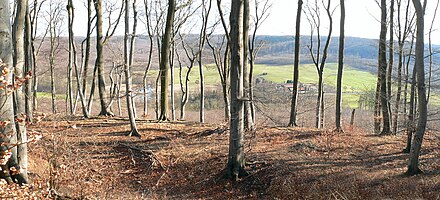Elm-Lappwald Nature Park
The Elm-Lappwald Nature Park is a nature park in south-eastern Lower Saxony, east of Braunschweig . It is shaped by the wooded ridges of Elm , Lappwald and Dorm as well as the area of the Helmstedter Mulde.
geography
location
The nature park has an area of around 470 km² and is located in the districts of Helmstedt and Wolfenbüttel . It is limited to the west by the outskirts of Braunschweig and to the north by Wolfsburg . In the northern area, the federal motorway 2 cuts through the park in the Hanover-Berlin section. The nature park comprises the mountain ranges, landscapes and forest areas of Elm, Lappwald, Dorm, Elz , Helmstedter Mulde, Rieseberg and Rieseberger Moor as well as the Kampstüh forest near apprenticeship .
In terms of landscape, the nature park belongs to the East Westphalian hill country . It is located in the transition area between the low mountain range with the Harz in the south and the north German lowlands with the Lüneburg Heath in the north. Climatically, the area lies in a west-east direction in the transition zone between maritime and continental weather influences.
history
Park history
The nature park was founded in 1977 as a cooperation between the districts of Helmstedt, Wolfenbüttel and the city of Braunschweig. The Elm-Lappwald Nature Park is now part of the UNESCO and European Geopark Harz - Braunschweiger Land - Ostfalen .
Soil history
The last Ice Age ( Vistula Ice Age ) around 12,000 years ago deposited a layer of loess up to three meters thick in the southern part of the Helmstedter and in the entire course of the Schöppenstedter Mulde , on which the fertile black and brown soils were formed. During the thawing periods, the ice masses created the fine forms of this landscape. Dense deciduous forest vegetation developed in the post-ice age and covered the entire area of today's nature park. Their tree species adapted to the respective soil conditions. In the northern area of the park, oak-hornbeam forests alternated with beech-oak forests and swamp forests on wet, peaty locations ( fen areas ). In the southern part the beech forests dominated.
Settlement history
The area of today's nature park was already permanently settled in the 6th millennium BC, as evidenced by megalithic graves. With the settlement of this area by humans, the naturally grown vegetation changed. It is true that the first settlers in the Middle Stone Age as hunters, fishermen and gatherers did not yet have any notable part in this change. The basin of the area with approaches to the loess soil made for a settlement by early arable cultures as early as the Stone Age . They cleared the dense tree population early on. The greatest loss of forest areas was brought about by the great clearing (900 to 1200 AD), when the natural landscape was "cultivated" at this time. Place names that end in -rode, -hörst, -feld still indicate this settlement period. The Mariental Cistercian monks created a particularly large number of clearing villages . Abbenrode, Hemkenrode and Erkerode on the northwest slope of the Elm and Rotenkamp on the Rieseberg go back to this time . In the Middle Ages there were significantly more settlements in this region. Almost half of them were abandoned by their inhabitants and fell into disrepair, they became desolate , the number of which is particularly high in the Lappwald, on the Dorm and on the southwest slope of the Elm . The area with its good soils has remained a preferred arable site to this day. The cities of Königslutter , Schöningen , Schöppenstedt and Helmstedt have been historical places in the area of today's nature park since the Middle Ages . The location on the trade route from Braunschweig to Magdeburg , today's Bundesstraße 1, was decisive for the early development of Helmstedt, which began in 952 .
Flora and fauna
The Elm is the largest beech forest in northern Germany . The appearance of the nature park includes large areas of forest, moors, spring rivers, lakes, heather areas, salt marshes and species-rich lime grasslands. There are over 800 plant species, of which more than ten percent are endangered. Birds , mammals and amphibians are represented in the nature park habitat in many ways. The Reitlingstal in the Elm and the Brunnental in the Lappwald are particularly idyllic .
literature
- Elm-Lappwald Nature Park , photographed by Peter Hamel, text by Hermann Gutmann a. Friedrich Schröder, Hamburg 1989, Ed .: Hans Christians, Hamburg

